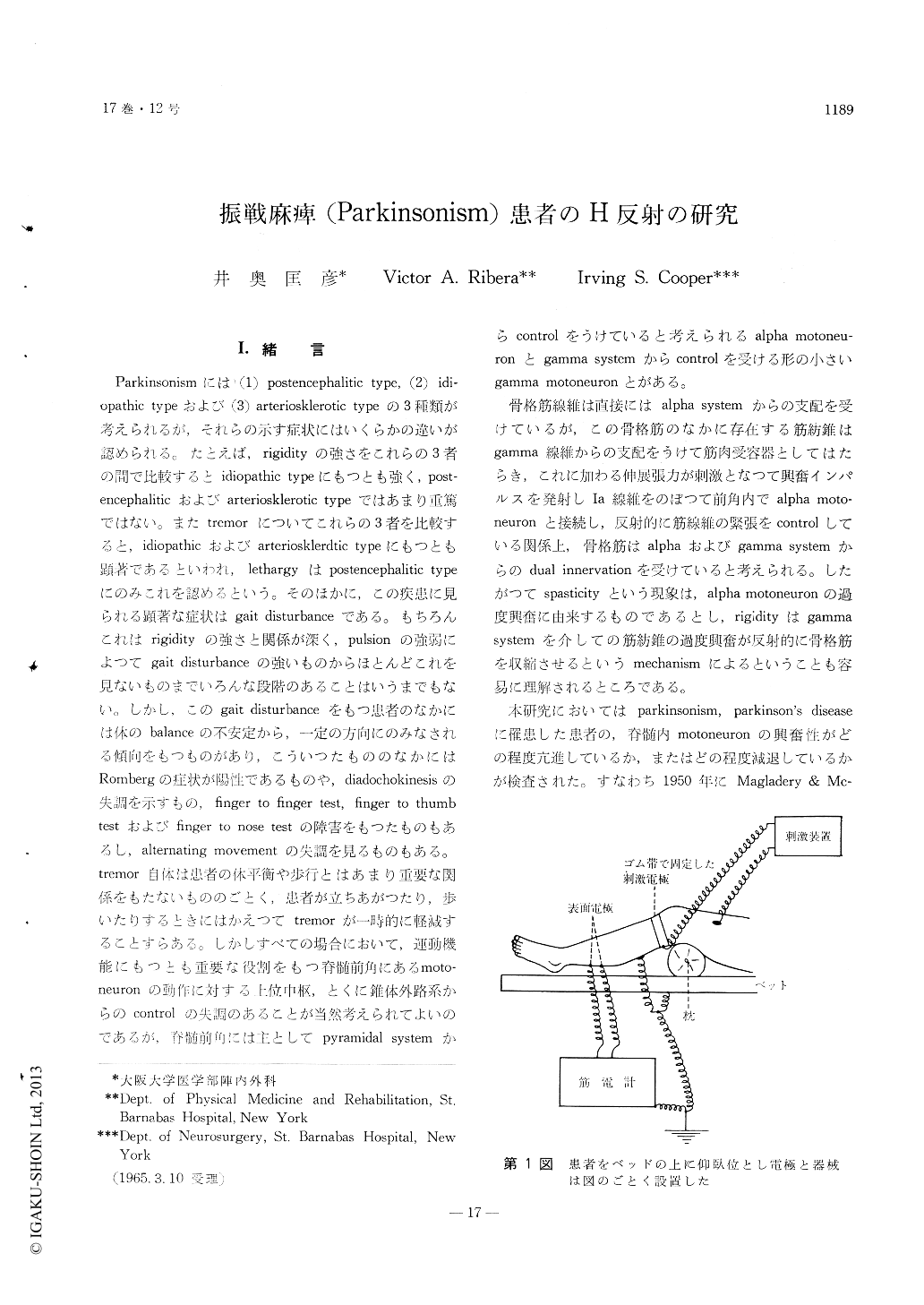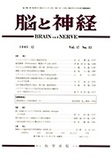Japanese
English
- 有料閲覧
- Abstract 文献概要
- 1ページ目 Look Inside
I.緒言
Parkinsonismには(1) postencephalitic type,(2) idi—opathic typeおよび(3) arteriosklerotic typeの3種類が考えられるが,それらの示す症状にはいくらかの違いが認められる。たとえば,rigidityの強さをこれらの3者の間で比較するとidiopathic typeにもつとも強く,post—encephaliticおよびarteriosklerotic typeではあまり重篤ではない。またtremorについてこれらの3者を比較すると,idiopathicおよびarteriosklerdtic typeにもつとも顕著であるといわれ,lethargyはpostencephalitic typeにのみこれを認めるという。そのほかに,この疾患に見られる顕著な症状はgait disturbanceである。もちろんこれはrigidityの強さと関係が深く,pulsionの強弱によつてgait disturbanceの強いものからほとんどこれを見ないものまでいろんな段階のあることはいうまでもない。しかし,このgait disturbanceをもつ患者のなかには体のbalanceの不安定から,一定の方向にのみなされる傾向をもつものがあり,こういつたもののなかにはRornbergの症状が陽性であるものや,diadochokinesisの失調を示すもの,finger to finger test, finger to thumb testおよびfinger to nose testの障害をもつたものもあるし,altemating movementの失調を見るものもある。tremor自体は患者の体平衡や歩行とはあまり重要な関係をもたないもののごとく,患者が立ちあがつたり,歩いたりするときにはかえつてtremorが一時的に軽減することすらある。しかしすべての場合において,運動機能にもつとも重要な役割をもつ脊髄前角にあるmoto—neuronの動作に対する上位中枢,とくに錐体外路系からのcontrolの失調のあることが当然考えられてよいのであるが,脊髄前角には主としてpyramidal systemからcontrolをうけていると考えられるalpha motoneu—ronとgamma systemからcontrolを受ける形の小さいgamma motoneuronとがある。
骨格筋線維は直接にはalpha systemからの支配を受けているが,この骨格筋のなかに存在する筋紡錐はgamma線維からの支配をうけて筋肉受容器としてはたらき,これに加わる伸展張力が刺激となつて興奮インパルスを発射しIa線維をのぼつて前角内でalpha moto—neuronと接続し,反射的に筋線維の緊張をcontrolしている関係上,骨格筋はalphaおよびgamma systemからのdual innervationを受けていると考えられる。したがつてspasticityという現象は,alpha motoneuronの過度興奮に由来するものであるとし,rigidityはgamma systemを介しての筋紡錐の過度興奮が反射的に骨格筋を収縮させるというmechanismによるということも容易に理解されるところである。
Studies of the monosynaptic reflex in 70 parkinson-ian patients and 12 normal individuals were carried out.
Using Magladery's method recovery curves were-plotted utilizing the relationship of the H wave obtained after each of two successive stimuli (H2/H1). In addi-tion, a personal modification consisting of recording the facilitatory conditions of the lower motor neuron, using again two successive stimuli in the 1~10 msec range was determined at the same time. The results for the 12 normal subjects are summerized in fig. 2. In the facilitation curve the H2/H1 ratio fell between 50~80% and in the recovery curve the shortest interval between the 1st and 2nd stimulation which gave a H2/H1 ratio greater than 10%, was of 80 msec.
Facilitation and recovery curves of parkinsonian patients differed from those of normal subjects (fig. 2~6). Within the parkinsonian group four different types of facilitation and recovery curves were seen. These corresponded to certain clinical variations in each of these groups.
In group 1, characterized by high facilitation curve and a rapid recovery curve the patients demonstrated principally tremor and/or rigidity but were functional and did not demonstrate muscle atrophy.
Patients in group 2 had a low facilitation curve and rapid recovery curve. This group, in addition tremor and rigidity demonstrated objective muscular atrophy in the extremities.
Patients in group 3 had high facilitation but slow recovery curves. The objective neurologic signs were principally tremor with little or no rigidity. In this group balance during ambulation was impaired, out of proportion to the observable rigidity.
In group 4 the facilitation curve was low and the recovery curve was slow. In this group tremor and rigidity were accompanied by muscle atrophy, balance disturbances and a good deal of vegetative symptoms.

Copyright © 1965, Igaku-Shoin Ltd. All rights reserved.


